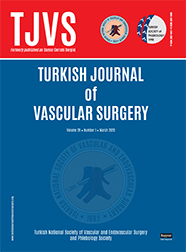
The Turkish Journal of Vascular Surgery
Yazarlar: Vedat YILDIRIM, Suat DOĞANCI, Artan JAHOLLARI, E. Arzu KÖSE, Ufuk DEMİRKILIÇ, Ahmet ÇOŞAR
Konular:-
Anahtar Kelimeler:Sedation,Midazolam,Dexmedetomidine,Femoral embolectomy
Özet: Objective: Femoral artery (FA) embolectomy surgery is commonly performed under local anaesthesia with midazolam sedation. Dexmedetomidine is a highly selective α-2 agonist with sedative, analgesic, and anxiolytic effects and its use in FA embolectomy surgery has not been reported. This double-blind study compared the use of dexmedetomidine and midazolam in patients undergoing FA embolectomy. Material and Methods: Forty patients undergoing femoral embolectomy under local anaesthesia randomly received either i.v. dexmedetomidine (Group I) (n=20) 1 microg/kg over 10 min; followed by 0.1-0.6 μg/kg/h i.v. infusion, or midazolam (Group II) (n=20) 20 μg/kg i.v.; followed by 0.5 mg i.v. boluses as required. Sedation was titrated to a Ramsay sedation score of 2-4. Mean arterial pressure (MAP), heart rate (HR), respiratory rate (RR), oxygen saturation (SpO2), readiness for recovery room discharge (time to Modified Post Anesthesia Discharge Scoring System (MPADSS) score of 9-10), and patients" pain scale (on NRS scaling system) were determined. Results: MAP and HR were lower in Group I compared with Group II. Group I patients had slightly lower postoperative supplemental fentanyl need when compared with patients in Group II. Group II patients had slightly higher respiratory rate, but this was not statistically different from group I. There was no difference for SpO2 between two groups. MPADSS score 9 and 10 were significantly higher in Group I. Conclusion: Compared with midazolam, dexmedetomidine appears to be suitable for sedation in patients undergoing femoral embolectomy surgery. While recovery room discharge was a little longer, there was a slightly better subjective patient satisfaction and it was accompanied by haemodynamic profile amelioration desirable in patients undergoing FA embolectomy who have more frequent coronary artery disease and are at greater risk for perioperative myocardial ischemia than the general population in group I.